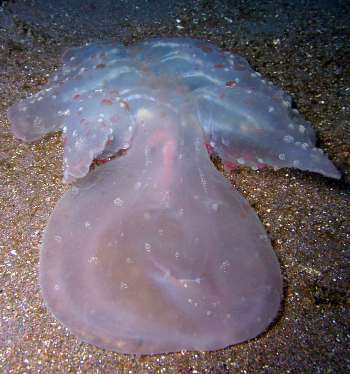
Melibe japonica
Eliot, 1913
Order: NUDIBRANCHIA
Suborder: DENDRONOTINA
Family: Tethydidae
DISTRIBUTION
Known from Japan, Korea. Also reported on Forum from Eastern Australia [see #21985 ]
PHOTO
10m off of Osezaki beach, Japan. 12 - 16 inches [30-40cm] long, with an oral hood diameter of 6 inches [15cm]. Photo: Jason Bell
Melibe japonica was described by Charles Eliot (1913) from a preserved specimen. He described the colour as "transparent yellowish white, with a strong reddish tinge in parts" but I suspect that refers to its preserved state.
Baba, (1949) reports that living specimens, which he identifies with Melibe japonica, are 'not common' on the Pacific coast of Japan. He describes the species as "colossal, often attaining over 50cm in length, and with a strikingly large hood and expanded foot, and small rhinophore sheaths. He describes the body colour as pinkish with the hood margin and various tubercles as deeper reddish. Blunt tubercles, often pink or red are scattered over the oral hood, sides of body and cerata. Baba and Eliot both describe bushy or dendritic papillae irregularly arranged down the midline of the body between the cerata.
Note added 22 October 2008: Melibe mirifica is considered a synonym [#21985]
-
Baba, K (1949) Opisthobranchia of Sagami Bay collected by His Majesty The Emperor of Japan. Iwanami Shoten, Tokyo. 194pp., 50 Pls.
-
Eliot, C.N.E. (1913) Japanese nudibranchs. Journal of the College of Science, Tokyo Imp. University, 35: 1-47. (Pls.1-2)
Rudman, W.B., 2004 (January 28) Melibe japonica Eliot, 1913. [In] Sea Slug Forum. Australian Museum, Sydney. Available from http://www.seaslugforum.net/find/melijapo
Related messages
Re: Melibe japonica from sthn Queensland
October 24, 2008
From: Brian Francisco
Concerning message #21984:
Bill
Perhaps you could forward Kathy's photos of the trawler catch on to the education department of the Australian Museum. While I appreciate how the SSF is using the photos for scientific purposes, they nonetheless depict the disheartening truth of our commercial fishing practices, and in particular the destructive nature of shrimp trawling.
It's a bit ironic that this current topic thread began with Coleen McGrath's submission in which she describes the Melibe as an "incredibly beautiful sea creature" that "appeared almost to be 'showing off', twisting and twirling around for 30 minutes". And now we see these wonderful creatures (as well as lots of other "bi-catch") laying dead on the deck of a fishing boat.
Maybe these photos can help educate the public about the methods used in our commercial fishing industry and the true cost of a kilo of shrimp.
Thanks
Brian Francisco
francisco.brian@gmail.com
Francisco, B., 2008 (Oct 24) Re: Melibe japonica from sthn Queensland. [Message in] Sea Slug Forum. Australian Museum, Sydney. Available from http://www.seaslugforum.net/find/21990Thanks Brian,
Bill Rudman
Re: Melibe japonica from sthn Queensland
October 23, 2008
From: Kathy Townsend

Concerning message #21984:
Hi Bill,
Thank you for this. I am interested to hear what forum members have to say. I have also attached a photo of the animal that had been washed up in front of the research station here in Dunwich, Moreton Bay, sthn Queensland, on 17 August 2008 which we made our original Melibe japonica identification with.
PHOTOS: Upper: ventral view of oral hood, and body on its side; Middle Left: inside view of part of oral head showing tactile papillae around the edge; Middle Right: close-up of back showing dense covering of whitish gills. Note also red dots, and pustules covered in white dots. Lower: dorsal view of body and oral hood [- oral hood apparently torn in dorsal midline].
Although it is missing its cerata, it might be of some use for the Forum members as it is clearer than the photo from the trawler.
Cheers,
Kathy
kathy.townsend@uq.edu.au



Dear Kathy,
Thanks for these photos. It ceratinly puts the 'bits' in the earlier photo into context. In Dong Bum Koh's photo from Korea [message #17605] you can see the white gills covering the back of the animal. Even though the animal in your photo is in bad shape, the same gills are clearly visible. It certainly strengthens my belief that this is M. japonica.
Best wishes,
Bill Rudman
Melibe mirifica & M. japonica - the same species
October 22, 2008
From: Bill Rudman

Following today's message of a huge Melibe in southern Queensland [#21984], which is almost certainly M. japonica, I checked earlier records of large Melibe from the region and it became quickly apparent that Joyce Allan's description of Melibe mirifica from Cairns, in northern Queensland, fitted M. japonica very well. The size, and extremely large oral veil, and large pink and red pustules all over the cerata and body are identical.
PHOTO: Scan of part of Pl. 23 from Allan (1932) illustrating the preserved specimen of Melibe mirifica.
In the most recent review of the genus (Gosliner & Smith, 2003), Melibe mirifica is considered a possible synonym of M. viridis [based on what I would consider misidentified photos] and M. japonica is considered unidentifiable. However the large size of the animal, the proportionally large oral hood, reddish pigmentation, and gills all over the dorsum, have allowed Japanese workers to identify M. japonica with little difficulty, and Allan's M. mirifica is clearly the same species, so I have no hesitation in identifying them all as M. japonica.
Previously on the Forum I have identified some animals from Papua New Guinea and Indonesia as M. mirifica [see messages #3026, #12461, #19393], because of their size and conical pustules, but the smaller oral veil and lack of red pigmentation are rather different, so I have placed them separately as Melibe cf. mirifica. [Note added 24 October 2008: These three animals are most probably a colour form of M. viridis - see message [#21988]]
The only published record of Melibe mirifica is Allan's description of a specimen found swimming around the Cairns wharf in 1931. The following description is an edited version of Allan's original description:
"Animal very large, over a foot [30 cm] in length, gelatinous and fairly transparent, conspicuous. Foot very broad and solid, wider at the anterior end, rounded at the posterior end. At the front of the body the heda is replaced by an enormous circular membranous oral hood or veil, about 7-8 inches [20cm] in diameter, as long as the foot and about half the size of the animal. When expanded the veil looks like a large jelly-fish. Round its thickened edges are about four rows of numerous irregular-sized cilia, the largest ½ inch [1cm] long. The rows are interrupted for about two inches at the central posterior, and central anterior portion of the margins. Within the veil at the posterior end is a large rounded mouth with thick fleshy lips. The rhinophores are slender and can retract into large stalked sheaths, broad at their tops and slender at the base, situated about half-way along the dorsal surface of the oral veil. Along each side of the body are five to seven variously sized and bluntly shaped cerata with broad bases and their upper margins divided into about three lobes. The largest ceras was about four inches high [10cm] and stood well up beyond the back of the animal. It was constantly in movement and was one of the first to be cast off. When removed from the water after being cast off, it gave out a sickly sweet smell, showed signs of life for several days, and when touched would curl up its edges and exhibit general movement. The remaining cerata, ranging from half inch [1cm] to two inches [5cm] in size, grew rapidly. They were colourless, except for minute speckling, and by the time the animal died had all been cast off. The whole dorsal surface of the animal is covered with large and small blister-like pustules, which are capable of contracting and expanding. Along the central back is a dense mass of fluffy branched 'gills' which, with the pustules and cerata, are constantly in movement. The animal is transparent and gelatinous, with a beautiful pinky-blue tinge over it. The cilia round the veil are deep rose-pink, except the uppermost row, which is white. A minute speckling of rose-pink is over the animal, especially round the veil edge. Inside the veil edge is a deep border, about an inch wide, of this speckling, which shows through to the outer surface. The pustules over the surface are rich rose-pink or white. The branched filaments along the back are a smokey-grey with pinkish tinge. These are tipped with silvery-white. The small cerata had suggestions of pustules on them, but were practically colourless. The large one was a most vivid ornamentation to the animal. When on the animal it had a large thick rachis with the upper end expanded into a thick club-shaped structure. Gelatinous like the body, it had large fluffy white and ruby-red protuberances on it. On the upper portion of the side away from the body was a large brilliant magenta patch of colour with big white pustules on it. The branched filaments scattered over the animal were a pale brown with faint speckling on them. The foot was colourless."
-
Allan, J.K. (1932) A new genus and species of sea-slug, and two new species of sea-hares from Australia. Records of the Australian Museum, 18(6): 314-320.
-
Gosliner, T. M. and Smith, V. G. (2003) Systematic review and phylogenetic analysis of the nudibranch genus Melibe (Opisthobranchia: Dendronotacea) with descriptions of three new species. Proceedings of the California Academy of Sciences, 54: 302-355.
Melibe japonica from sthn Queensland
October 22, 2008
From: Kathy Townsend & John Kirkwood

Concerning message #21272:
Dear Bill,
We have since had additional sightings of the Melibe sp. The local prawn trawlers are picking them up in their nets. John Kirkwood from Griffith University has been recording them on observer trials and they have recently started picking up as much as 4 kg of the animals per net. John Healy and I are starting to feel even more strongly that it is probably Melibe japonica, if only for the colour alone. It is very red/pink. While M. viridis is thinner and green - unless they show a marked variation of colour we are unaware of.
While this is a really bad shot of the animals on the deck of a trawler, you can see the colour and the dropped off cerata within the mess. We would really appreciate your opinion. Particularly since there is some concern that they may have recently populated Moreton Bay, southern Queensland in large numbers and are becoming a pest species for the prawn trawlers.
Here is a comment from one observer: "we pulled up this species that were just a gelatinous mass (red spots/lines on them) - fisherman said they had only just started seeing them in Moreton Bay. We pulled up buckets of them, ranging from palm size to half kilo in weight".
Thanks,
Kathy and John
kathy.townsend@uq.edu.au



Dear Kathy and John,
Although the photos are not perfect 'specimen shots' they certainly show the reddish pustules which seem to be characteristic of Melibe japonica, so I agree with your identification. Your suggestion that this may be a recent introduction to Queensland sent me back to earlier reports of Melibe from your part of the world, in particular Joyce Allan's description of Melibe mirifica from Cairns. As I discuss in a separate message [#21985] I am now of the opinion that M. mirifica and M. japonica are the same species. I guess I should have picked up on this earlier, but when I last looked at the original Melibe mirifica description I had not seen photos of living M. japonica and so did not know it had red pustules, as its original description was also rather lacking in detail.
What this means is that I am pretty sure this animal is not a recent introduction to Queensland, it has been there since at least 1931, and could be widespread throughout the western Pacific. I also think that the animals I previously identified as M. mirifica [#3026, #12461, #19393] are not that species.
I assume the swimming animal in the message from Colleen McGrath that you originally referred to [#21272] is also M. japonica, but although it is a good photo of swimming, and has a reddish tinge, it doesn't give any good clues which would allow me to confirm its identity.
Best wishes,
Bill Rudman
Melibe from sthn Queensland
February 14, 2008
From: Colleen McGrath
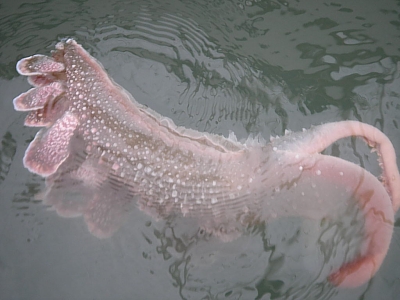

This incredibly beautiful sea creature appeared next to our boat at the marina in Moreton Bay. She was bright pink and appeared almost to be 'showing off', twisting and twirling around for 30 minutes.When we touched her on the side, the two large finger like appendages puffed up and spread apart approximately 30 cm , linked by a thin membrane the "fingers" each showed a bright red round spot the size of a fifty cent piece.We would love to know what her real name is.
Locality: Moreton Bay Boat Club, Scarborough, 2 metres, Queensland, Moreton Bay, 03 December 2007, in the marina. Length: 50 cm. Photographer: Colleen McGrath.
Many thanks in anticipation.
Colleen McGrath
seakat31@bigpond.com
McGrath, C. A., 2008 (Feb 14) Melibe from sthn Queensland. [Message in] Sea Slug Forum. Australian Museum, Sydney. Available from http://www.seaslugforum.net/find/21272
Note added 22 October 2008: I am pretty sure this is Melibe japonica. See messages #21985, #21984.
Dear Colleen,
As I should be saying to everyone at the moment, sorry it's taken a while to reply but better late than never.
This is a species of Melibe which are amazingly shaped nudibranchs whose head has evolved into a large 'fishing net' which they use to catch and eat small crabs and shrimps. There is a species on the west coast of Nth America, M. leonina, which hangs on to the large kelp plants which grow there and stretches it 'fishing net' out into the water current to catch small plankton. Although most species are able to swim, like your was doing, they usually crawl around on the bottom with their net wide open feeling for small crustacea with the fine tentacles around the 'lips' of the net. I have never seen one with the pink patches in the 'net' which we can clearly see in your photo alongside. The skin their is very thin so I can't say whether the pink patches are lumps of tissue [glands perhaps?] in the skin or whether they are lumps of food? which the Melibe has collected from the water. Perhaps its is collecting small plankton as it is swimming around. Since I have never seen such lumps before I can only make a wild guess at what they are.
To get an idea of the shape and variety found in this group of sea slugs use the menu list on the top left of the page to go to the Taxonomic Search page and search for Tethydidae. It will take you to a list of Fact Sheets on different species of Melibe and its relatives. If you look at those pages, and the messages attached, you will find a lot of information on the group. Unfortunately from your photos I can't see enough detail to identify exactly which species you saw, but it was most probably Melibe viridis.
Best wishes,
Bill Rudman
Swimming Melibe japonica from South Korea
November 9, 2006
From: Dong Bum Koh
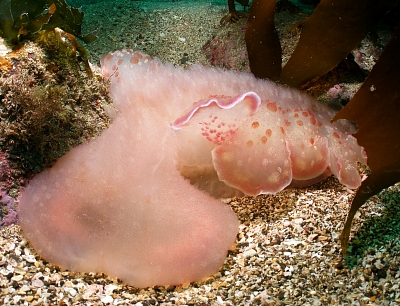
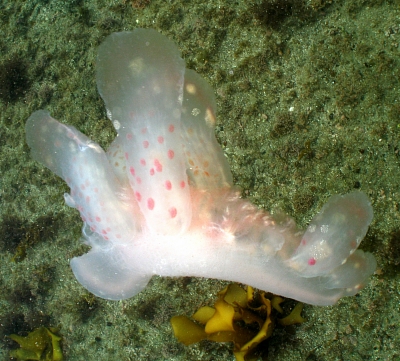
Dear Bill,
I received full sized images from my friend and I think they are of Melibe japonica were taken .
These 3 individual animals were taken during one day (17 June 2006) at in Jeju island. The upper was taken at 11:30 in Sung San beach -15 m sandy bottom. Middle and lower two animals were swimming taken during second diving at 16:30 at another diving point near Sung San beach.
Locality: Sung San (East coast of Jeju), -15 m, Jeju. Korea, Pacific, 17 June 2006, -. Length: More than 300 mm. Photographer: Jong Won Uh.
Could you let me know about these animals?
Best regards,
Dong Bum Koh
drkoh@seasee.co.kr
D.B.Koh, 2006 (Nov 9) Swimming Melibe japonica from South Korea. [Message in] Sea Slug Forum. Australian Museum, Sydney. Available from http://www.seaslugforum.net/find/17605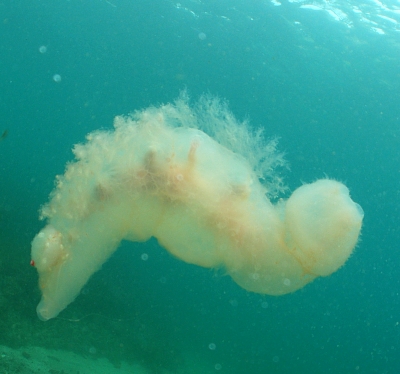
Dear Koh,
Thanks for these interesting photos of Melibe japonica. The upper and lower photos show the bushy or dendritic papillae on the back that both Baba and Eliot describe, and are not clear in earlier photos on the Forum. The swimming animal in the lower photo seems to have lost all its large cerata.
Best wishes,
Bill Rudman
More on Melibe japonica? from Japan [1]
February 3, 2004
From: Jason Bell
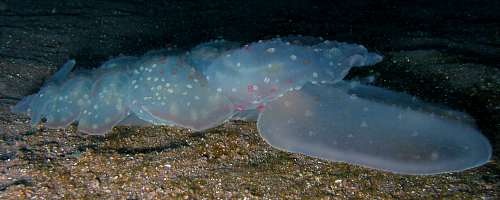
Bill,
Thanks for your comments.
The Melibe japonica was found on Jan 11, 2004. It was late afternoon 2:30 - 3pm and we had an incoming tide. I have attached all the photos straight from the camera. You can see the rhinophores in some of the photos. I am sorry to say that I do not have any specific shots of the midline of the creature.
Jason Bell
belljason@hotmail.com
![]()
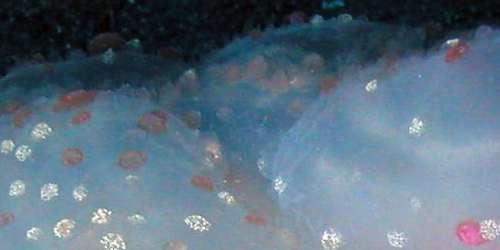

Thanks Jason,
These are a very valuable addition. I have split your photos into 3 messages [see message 2, message 3]. Now that I have looked at these photos I am even more convinced that your animal is Melibe japonica. The reddish tinge to parts of the body, the reddish tubercles, the proportionally large oral hood, and the small rhinophore sheaths, all fit the known features of this species.
The main anatomical doubt is the apparent absence of branched papillae in the dorsal midline between the cerata. However in your new photos there are clearly raised tubercles doen the midline. Unfortunately I can't see enough detail to know whether the lumps we can see are retracted branches tubercles or not. They can be seen in the lower photo above, which is a close-up of part of the upper photo, and in the photo alongside [in oval ring] which is a closeup of the head. The object in the circular ring is the left rhinophore and sheath.
Best wishes
Bill Rudman
More on Melibe japonica? from Japan [2]
February 3, 2004
From: Jason Bell
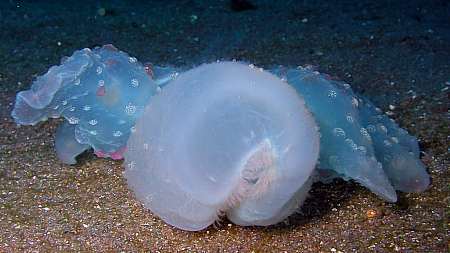

Here are some more of my photos of Melibe japonica [see message 1, message 3].
PHOTOS: Upper photo: Head-on view of the animal showing partly raised oral veil. Lower photo: Close-up od folded edge of oarl veil showing the sensory papillae. Photos: Jason Bell.
Jason Bell
belljason@hotmail.com
Bell, J., 2004 (Feb 3) More on Melibe japonica? from Japan [2]. [Message in] Sea Slug Forum. Australian Museum, Sydney. Available from http://www.seaslugforum.net/find/12077Thanks Jason,
Bill Rudman
More on Melibe japonica? from Japan [3]
February 3, 2004
From: Jason Bell
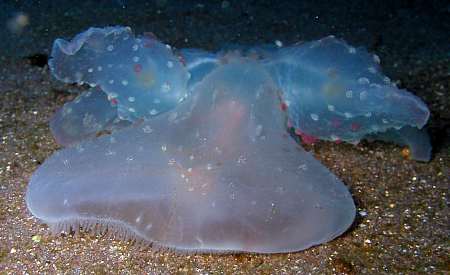
Here are some more of my photos of Melibe japonica [see message 1, message 2].
PHOTOS: Upper photo: Head-on view of the animal. Lower Left photo: Close-up showing the sensory papillae that line the edge of the oral veil, and are used to sense crustacean prey in the sand. Lower Right: Close-up of part of oral veil to relatively small rhinophores. Photos: Jason Bell.
Jason Bell
belljason@hotmail.com

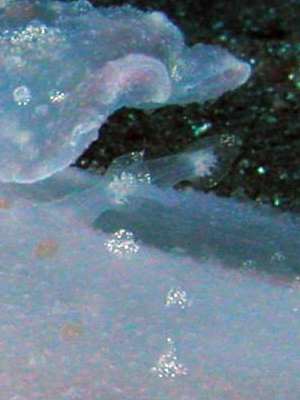
Thanks Jason,
Bill Rudman
Melibe japonica? from Japan
January 30, 2004
From: Jason Bell
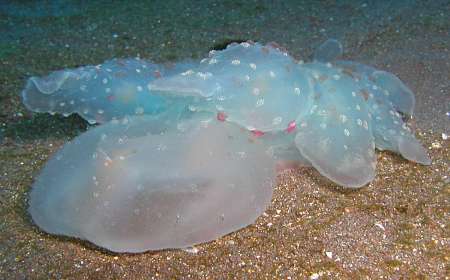
We found this Melibe in about 10m off of Osezaki beach, Japan. I searched the site and have not been able to identify it. The books that I have for Japan only list Melibe papillosa with a max size of 5cm, but this specimen was at least 12 - 16 inches [30-40cm] with an oral hood diameter of 6 inches [15cm].
Thanks for your help
Jason Bell
belljason@hotmail.com

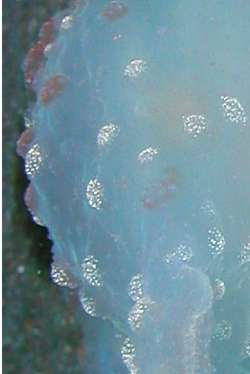
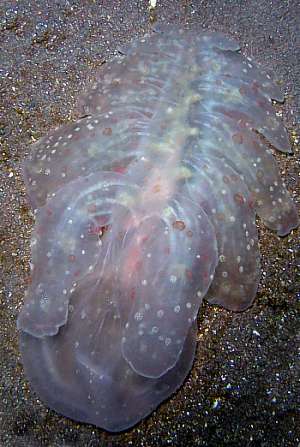
Dear Jason,
I think this is a species which has never before been illustrated. I am pretty sure it is Melibe japonica which was described by Charles Eliot (1913) from a preserved specimen. He described the colour as "transparent yellowish white, with a strong reddish tinge in parts" but I suspect that refers to its preserved state. Baba, (1949) states that living specimens, which he identifies with Melibe japonica, are 'not common' on the Pacific coast of Japan.
He describes it as "colossal, often attaining over 50cm in length, and with a strikingly large hood and expanded foot". I can't see the rhinophores in your photos but Baba describes the 'rhinophore sheaths as small' which may explain my difficulty. Baba also describes the body colour as pinkish with the hood margin and various tubercles as deeper reddish. He also describes blunt tubercles on the oral hood, sides of body and cerata. The only difference I can see is that both Baba and Eliot describe bushy or dendritic papillae irregularly arranged down the midline of the body between the cerata. I can't see these in your photos but it is possible that a series of fuzzy reddish bumps I can see in one of your full size photos are retracted papillae. So I would be grateful if you could check any other photos you have to see if you can see papillae on the back, or a clearer shot of the centre of the back, between the cerata, so I can see if there is any sign of retracted papillae. I would also be grateful if you could let me know when you photographed this animal.
It is a very interesting find. Perhaps Terry Gosliner can give us his views on it
Best wishes
Bill Rudman
